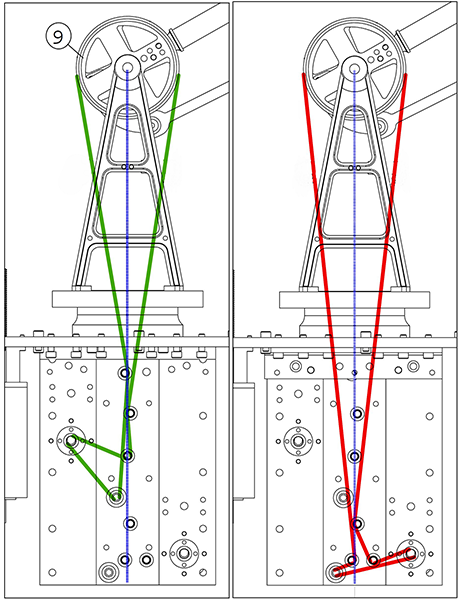This project included the design and implementation of VirSense, a novel 6-DoF haptic device with an emphasis on its gravity compensation and fixed-base motors. VirSense has a serial linkage mechanism and it is the 1st serial haptic device that uses a passive system for gravitational compensation. The passive system includes linear springs to compensate the forces and torques generated by the weight of the moving part of the robot without increasing the effective mass and inertia of the robot. Using the inverse dynamics, the effect of gravity on each joint has been determined and based on those values the stiffness coefficients of the designed springs are determined.

CAD model of VirSense haptic device.
This novel spring system allows VirSense to compensate 95% of the gravity torque passively by the springs and 5% actively by the motors. This gravity compensation is effective in the entire workspace of VirSense. In serial robots, actuators are normally placed at each active joint and move with the previous link. Therefore, fixing actuators to the base is a challenging issue. The novel cabling mechanism in VirSense allowed us to install all motors (one for the yaw axis and two for the pitch axes) on a fixed base so that the moving mass/inertia and as a result the effective mass/inertia of the robot are reduced. This approach makes using larger and more powerful motors possible which leads to higher haptic force capacity in interaction with the user.

Wire routes for 1st pitch (left) and 2nd pitch (right) in VirSense.
In addition, kinematics, Jacobian matrix, singular points, and the workspace of VirSense are determined. A customized pulley mechanism has been designed and placed in the bottom section of the robot as a guide for power transmission cables from the motors to the links. This structure prevents the cables from rupture, entanglement, or length variation. To have permanent tension in the cables, the cable from each motor acts for both extension and flexion. Cabling system has been designed such that the cables connected to the pitch disks will not change length with the change of the yaw angle. No interference with other cables will occur either.
The novel features of VirSense robot in comparison with Phantom PP1.5HF are: eliminating body motions for all three motors; allowing more powerful motors; producing larger instantaneous and continuous forces; eliminating limitations in the physical size and weight of motors; compensating 95% of gravitational torques by springs in the entire workspace of the robot; and having twice workspace as PP1.5HF robot’s workspace.


